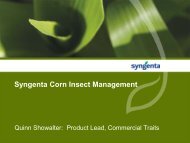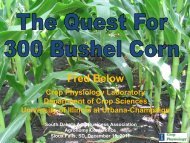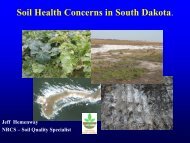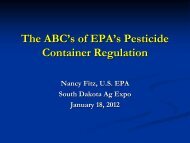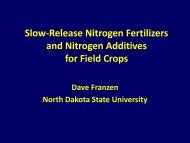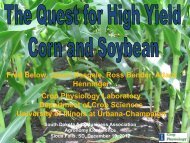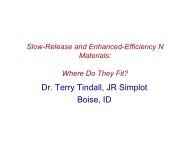Vertical Tillage: Benefits and Considerations
Vertical Tillage: Benefits and Considerations
Vertical Tillage: Benefits and Considerations
You also want an ePaper? Increase the reach of your titles
YUMPU automatically turns print PDFs into web optimized ePapers that Google loves.
Getting to the Bottom<br />
of Shallow <strong>Tillage</strong><br />
Jodi DeJong-Hughes<br />
Extension Educator Soils <strong>and</strong> Crops<br />
320-235-0726 ext 2006<br />
dejon003@umn.edu
<strong>Vertical</strong> vs. Horizontal <strong>Tillage</strong><br />
Horizontal tillage<br />
• Chisel<br />
• Cultivator<br />
• Strip tiller<br />
• Ripper<br />
<strong>Vertical</strong> tillage<br />
• Super coulter<br />
• Straight shank<br />
© 2011 Regents of the University of Minnesota. All rights reserved.<br />
swiderskiequipment.com, clarkagequipment.com
Differences in Equipment<br />
© 2011 Regents of the University of Minnesota. All rights reserved.<br />
fxtimes.com
© 2011 Regents of the University<br />
(mixing,<br />
of Minnesota. All rights<br />
depth<br />
reserved.<br />
<strong>and</strong> aggressiveness)
Individual vs. Gang Mounted<br />
(down pressure <strong>and</strong> rocks)<br />
© 2011 Regents of the University of Minnesota. All rights reserved.
Straight vs.<br />
gangs<br />
(mixing, aggressiveness <strong>and</strong> area covered)<br />
© 2011 Regents of the University of Minnesota. All rights reserved.
Harrows,<br />
Rolling Baskets,<br />
…<br />
© 2011 Regents of the University of Minnesota. All rights reserved.<br />
beavervalleysupply.com<br />
(Finishing <strong>and</strong> smoothing)
<strong>Vertical</strong> Till<br />
Classified as mulch till<br />
(shallow, full field tillage)<br />
© 2011 Regents of the University of Minnesota. All rights reserved.
<strong>Benefits</strong> of <strong>Vertical</strong> <strong>Tillage</strong>:<br />
Can get into wet fields<br />
© 2011 Regents of the University of Minnesota. All rights reserved.
Chops <strong>and</strong><br />
sizes residue<br />
© 2011 Regents of the University of Minnesota. All rights reserved.
Leaves some residue intact<br />
© 2011 Regents of the University of Minnesota. All rights reserved.
© 2011 Regents of the University of Minnesota. All rights reserved.
Primary <strong>and</strong> secondary tillage<br />
© 2011 Regents of the University of Minnesota. All rights reserved.
Speed - 7 to 10 mph<br />
© 2011 Regents of the University of Minnesota. All rights reserved.
<strong>Vertical</strong> <strong>Tillage</strong> Management<br />
10 hp per foot<br />
More for hills, dry soil, …<br />
© 2011 Regents of the University of Minnesota. All rights reserved.
Challenges for VT<br />
~ Incorporation<br />
© 2011 Regents of the University of Minnesota. All rights reserved.
© 2011 Regents of the University of Minnesota. All rights reserved.
Weed pressure<br />
ST<br />
VT<br />
© 2011 Regents of the University of Minnesota. All rights reserved.
VT in Dry Soil<br />
Disk<br />
September, 2012<br />
Wavy Coulter<br />
* 1 inch of rain in 3 months, late July to October, 2011<br />
© 2011 Regents of the University of Minnesota. All rights reserved.
Breaking up Compaction<br />
© 2011 Regents of the University of Minnesota. All rights reserved.<br />
verticaltillage.com
<strong>Vertical</strong> <strong>Tillage</strong> Management<br />
© 2011 Regents of the University of Minnesota. All rights reserved.
Get up to Speed!<br />
• Too slow - won’t get enough mixing<br />
• Too fast - float up out of ground<br />
© 2011 Regents of the University of Minnesota. All rights reserved.
© 2011 Regents of the University of Minnesota. All rights reserved.<br />
In Line VT
Field Cultivator<br />
© 2011 Regents of the University of Minnesota. All rights reserved.
© 2011 Regents of the University of Minnesota. All rights reserved.
3-4” Depth<br />
Even mixing<br />
of soil<br />
© 2011 Regents of the University of Minnesota. All rights reserved.
Good fertilizer<br />
<strong>and</strong> weed<br />
incorporation<br />
© 2011 Regents of the University of Minnesota. All rights reserved.
Challenges:<br />
30% residue remaining<br />
VT<br />
ST<br />
FC<br />
© 2011 Regents of the University of Minnesota. All rights reserved.
Smearing in a Wet Soil<br />
© 2011 Regents of the University of Minnesota. All rights reserved.
© 2011 Regents of the University of Minnesota. All rights reserved.<br />
Deere.com<br />
Shallow Disk
Levels <strong>and</strong> firms the seedbed<br />
© 2011 Regents of the University of Minnesota. All rights reserved.<br />
dot.ca.gov
Great at sizing residue <strong>and</strong> clods<br />
Too good<br />
© 2011 Regents of the University of Minnesota. All rights reserved.<br />
deere.com
Buries more residue than other<br />
2 o tillage tools<br />
© 2011 Regents of the University of Minnesota. All rights reserved.
Challenges for a Disk<br />
• Loss of soil structure<br />
• More compaction<br />
• Less residue<br />
© 2011 Regents of the University of Minnesota. All rights reserved.
© 2011 Regents of the University of Minnesota. All rights reserved.<br />
Disks in Dry Soil
Soil Finisher<br />
© 2011 Regents of the University of Minnesota. All rights reserved.
Even<br />
mixing of<br />
soil <strong>and</strong><br />
residue<br />
© 2011 Regents of the University of Minnesota. All rights reserved.
Chops <strong>and</strong> incorporates<br />
a lot of residue<br />
© 2011 Regents of the University of Minnesota. All rights reserved.
<strong>Benefits</strong> <strong>and</strong> Challenges<br />
of 2 Systems<br />
• ½ disk<br />
• ½ field cultivator<br />
© 2011 Regents of the University of Minnesota. All rights reserved.<br />
Kuhn.com
• Fall of 2009<br />
• Carlisle <strong>and</strong> Clarkfield, MN<br />
• Looking at varying residue levels<br />
© 2011 Regents of the University of Minnesota. All rights reserved.
Soybean Data - Clarkfield<br />
© 2011 Regents of the University of Minnesota. All rights reserved.
Corn Data - Clarkfield<br />
© 2011 Regents of the University of Minnesota. All rights reserved.
Corn Data - Carlisle<br />
2 Year Average<br />
Residue<br />
Yield<br />
<strong>Tillage</strong> Rotation (%) (bu/ac)<br />
Field Cultivation<br />
(prev. tillage NT)<br />
Strip Till<br />
(prev. tillage NT)<br />
Salford at 3” Depth<br />
(prev. tillage VT)<br />
Summers Super Coulter at 1”<br />
(prev. tillage VT)<br />
37.3 157.2<br />
62.3 163.7<br />
60.0 145.3<br />
73.7 134.5*<br />
© 2011 Regents of the University of Minnesota. All rights reserved.
<strong>Tillage</strong> too Shallow<br />
© 2011 Regents of the University of Minnesota. All rights reserved.
Soybean Data - Carlisle<br />
Residue Yield<br />
<strong>Tillage</strong> Rotation (%) (bu/ac)<br />
No Till<br />
(prev. tillage Field Cultivation)<br />
No Till<br />
(prev. tillage Strip Till)<br />
Salford VT<br />
(prev. tillage VT)<br />
Summers Super Coulter<br />
(prev. tillage VT)<br />
81.0 57.7<br />
78.3 56.9<br />
70.0 57.8<br />
71.0 58.1<br />
LSD (0.10) 7.2 NS<br />
© 2011 Regents of the University of Minnesota. All rights reserved.
Importance of Good Soil Structure<br />
Soil structure is your<br />
#1 defense against<br />
future compaction<br />
© 2011 Regents of the University of Minnesota. All rights reserved.
Create Soil Structure by:<br />
• Build or maintain organic matter<br />
• Maintain >30% residue coverage<br />
• Increase crop rotation<br />
• Add organic inputs<br />
(compost, livestock <strong>and</strong> green manure, cover or companion crops)<br />
© 2011 Regents of the University of Minnesota. All rights reserved.
Destroy Soil Structure by:<br />
• <strong>Tillage</strong> (recreational, aggressive)<br />
• Tight crop rotation<br />
• Compaction<br />
• No carbon or residue input<br />
(ex. burning)<br />
© 2011 Regents of the University of Minnesota. All rights reserved.
Kansas State Pilot Study<br />
Bulk Density<br />
0 - 2” 2 - 4”<br />
Infiltration<br />
(mm/hr)<br />
Corn Yield<br />
(bu/ac)<br />
<strong>Vertical</strong> Till 1.13 1.29 21.4 167.1<br />
No-Till 1.21 1.30 44.0 165.9<br />
P Value/T test 0.08 NS 0.04 NS<br />
VT at 2” depth - Case 330 Turbo Till<br />
NT field since the 1980’s (beautiful soil properties)<br />
No density increase below the depth of tillage (2”)<br />
Pressley, KSU, 2009<br />
© 2011 Regents of the University of Minnesota. All rights reserved.
Where to Try <strong>Vertical</strong> <strong>Tillage</strong><br />
• Sizing residue <strong>and</strong> introducing air<br />
• Wet Spring or Fall<br />
© 2011 Regents of the University of Minnesota. All rights reserved.
Where to Try<br />
<strong>Vertical</strong> <strong>Tillage</strong><br />
• Decrease residue build-up in reduce till systems<br />
• 50-60% of corn residue = good on slopes<br />
© 2011 Regents of the University of Minnesota. All rights reserved.
Where to Avoid<br />
<strong>Vertical</strong> <strong>Tillage</strong><br />
• In very dry soils<br />
• In long term No-till fields<br />
© 2011 Regents of the University of Minnesota. All rights reserved.
© 2011 Regents of the University of Minnesota. All rights reserved.<br />
Questions





